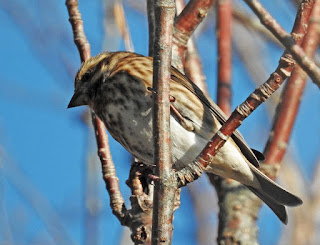NATURE
MONCTON INFORMATION LINE, December 18, 2019 (Wednesday)
To respond by e-mail, please address
your message to the information line editor, nelsonpoirier435@gmail.com .
Please advise the editor at nelsonpoirier435@gmail.com if any
errors are noted in wording or photo labelling. Note that corrections,
deletions, or delayed additions may not always appear on the Info Line and
email transcript but will always appear on the BlogSpot. For this reason, it is
recommended that those wishing to look at historical records use the BlogSpot
rather than the email transcript. The BlogSpot can always be accessed from
the website.
Edited by: Nelson Poirier nelsonpoirier435@gmail.com
Info Line # 506-384-6397 (384-NEWS)
** What an awesome EASTERN BLUEBIRD
[Merlebleu de l'Est] event for December 17th. Alain Clavette had 5
Eastern Bluebirds and one PINE WARBLER [Paruline des pins] traveling with them in
his Taylor Village yard on Tuesday. They were cavorting around the nest boxes and
visiting a Mountain Ash tree. Alain suspects that they were part of a group of
18 Eastern Bluebirds that visited his yard a month ago. At that time 2 Pine
Warblers were traveling with them. It’s been a great year for Eastern Bluebirds
in New Brunswick and now it is appearing that it was also a great year for Pine
Warblers as a significant number have been reported in the last few weeks.
** Brian Stone got a photo of BAYBERRY
[Myrique] in December, showing its winter clinging fruit and alternate red
buds. The berries have a large central seed, with a thin lipid layer coating.
The lipid layer of the berry makes it a potential winter food source for some
birds. The Yellow-rumped Warbler is sometimes seen using it. The berries can be
melted down to make a pleasant scented candle wax but it takes many, many
berries to end up with a candle.
Brian also got a photo of a Balsam Fir
tree laden with cones shedding their cone scales and seeds. Balsam Fir is the
only native conifer that arranges its cones vertically upward. Also some photos
of the interesting crystal shapes frost can make. A bird we are not seeing much
of at the moment, a PURPLE FINCH [Roselin pourpré], posed.
On Monday evening Brian got a nice photo in
the clear evening sky, at 12:38 am, actually the beginning moments of Tuesday,
of the white to blue-white star SIRIUS in the constellation Canis Major, which
is the brightest (visibly) star in the night sky. The blue-white star RIGEL and
the orange-red toned star BETELGEUSE show as well in the constellation of
Orion. While Sirius appears brightest to us in the night sky because it is
physically closer to us, the actual brightness of these three stars would be
ranked Rigel first and then Betelgeuse second and Sirius third if they were all
at the same distance from us.
** It appears that the INDIGO BUNTING
[Passerin indigo] has taken its leave of our Moncton feeder yard. We enjoyed it
and many folks dropped by to successfully have an audience with it from
December 6th to December 13th to get on the “count
period” but not on the “count day”. Oddly my small showing of 4 sparrows left
at the same time but a few dribbled back on Tuesday.
Nelson Poirier,
Nature Moncton
BALSAM FIR CONES SHEDDING SEEDS. DEC. 17, 2019. BRIAN STONE
PURPLE FINCH. DEC. 17, 2019. BRIAN STONE
BAYBERRY (WINTER BUDS AND CLINGING WINTER FRUIT) DEC 6, 2019. BRIAN STONE
BAYBERRY. DEC 6, 2019. BRIAN STONE
ORION CONSTELLATION (INCLUDING SIRIUS, RIGEL,AND BETELGEUSE). DEC. 17, 2019. BRIAN STONE
ORION CONSTELLATION (INCLUDING SIRIUS, RIGEL,AND BETELGEUSE). DEC. 17, 2019. BRIAN STONE
ORION CONSTELLATION . DEC. 17, 2019. BRIAN STONE
FROST. DEC. 17, 2019. BRIAN STONE
FROST. DEC. 17, 2019. BRIAN STONE







